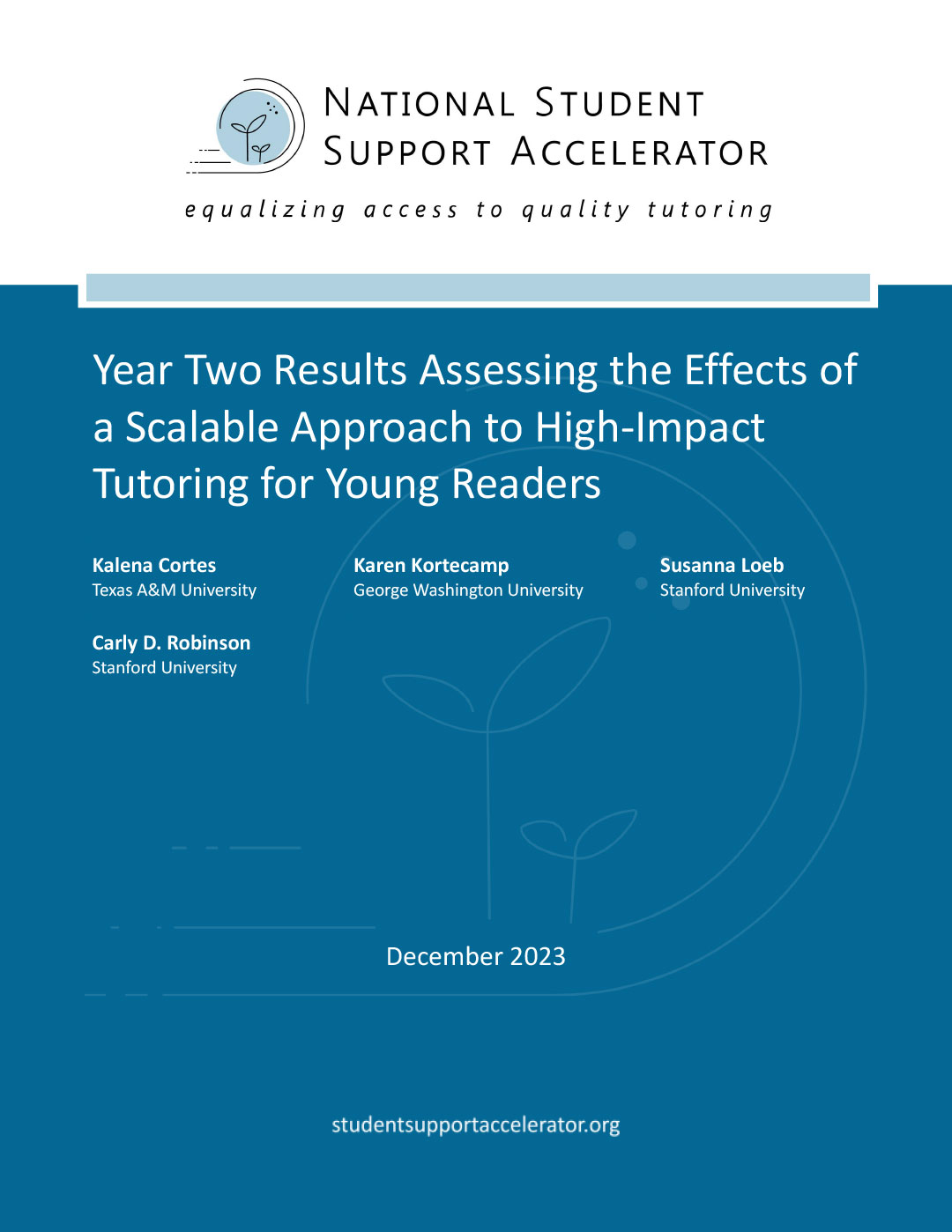Kalena Cortes, Karen Kortecamp, Susanna Loeb, Carly D. Robinson
This research report presents the results from the second year of a randomized controlled trial of an early elementary reading tutoring program that has been designed to be affordable at scale. During the 2021-22 school year, over eight hundred kindergarten students in a large Southeastern school district were randomly assigned to receive supplementary tutoring with the Chapter One program. The program continued during the 2022-23 school year, while the children attended first grade. The program embeds part-time tutors into the classroom to provide short bursts of instruction to individual students each week over the course of the school year. The consistent presence of the tutors allows them to build strong relationships with students and meet students’ individual needs at the moment they might most benefit from personalized instruction. The program focuses more time on students with the lowest literacy skills.
We find that students who participated in Chapter One’s program increased their early literacy skills on both program-collected and district-collected measures, meaningfully reducing their likelihood of being classified at risk in early literacy. The positive findings at the end of the second year of implementation continue to provide promising evidence of an affordable and sustainable approach for delivering one-on-one personalized literacy tutoring at scale.
Introduction
The ability to read is highly determinative of outcomes later in life, predicting high school test scores (Sparks et al., 2014) and graduation rates (Hernandez, 2012). However, students nationwide struggle with this skill. Only a third of fourth graders performed at or above proficient in reading on the most recent National Assessment of Educational Progress (US Department of Education, 2022).
High-impact tutoring offers a potent strategy for improving early literacy skills in young students. Meta-analyses have shown tutoring to be highly effective in increasing general academic achievement (Dietrichson et al., 2017; Nickow et al., 2020) and to be effective in early literacy specifically with effect sizes ranging from 0.24 to 0.41 SD (Elbaum et al., 2000; Gersten et al., 2020; Neitzel et al., 2022). Reading tutoring interventions that provide students with one-on-one, personalized reading instruction consistently demonstrate the largest improvements in reading achievement (Cavanaugh et al., 2004; Gersten et al., 2020; Neitzel et al., 2022; Slavin et al., 2011; Wanzek et al., 2018; Wanzek et al., 2016). Specific programs may differ in delivery or approaches, but most effective reading tutoring programs involve students meeting for 20-60-minute sessions several times a week with a consistent educator and use evidence-based reading curricula (Galuschka et al., 2014; Wanzek et al., 2018; Wanzek et al., 2016). These features align with the definition of “high-impact” tutoring, which involves substantial time each week spent in required tutoring; sustained and strong relationships between students and their tutors; close monitoring of student knowledge and skills; alignment with school curriculum; and oversight of tutors to assure quality interactions (Robinson & Loeb, 2021).
High-impact tutoring programs drive the large effect sizes cited in the literature, but they can be hard to scale and require substantial resources to implement (Groom-Thomas, et al., 2023). Successful tutoring programs often require dedicated tutoring blocks within the school schedule and cost, at a minimum, over $1000 per student (e.g., Guryan et al., 2021; Sirinides et al., 2018). Given the large expected effect sizes, high-impact tutoring is quite cost-effective at improving student learning outcomes (Guryan et al., 2021). However, the urgent and growing demand for high-impact tutoring programs to build children’s reading skills (U.S. Office of the Press Secretary, 2022) and common implementation issues (Carbonari et al., 2022), may prompt district leaders to search for even lower-cost programs that fit within existing school schedules.
In a prior report, we presented results from a randomized controlled trial of an early elementary reading tutoring program designed to be affordable at scale. During the 2021-22 school year, over eight hundred kindergarten students in a large Southeastern school district were randomly assigned to receive supplementary tutoring with the Chapter One program. The program embeds part-time tutors into the classroom to provide short bursts of instruction to individual students each week over the course of the school year. The consistent presence of the tutors allows them to build strong relationships with students and meet students’ individual needs at the moment they might most benefit from personalized instruction. We found that students who participated in Chapter One’s program were more likely to reach the target reading stage by the end of kindergarten and showed higher performance on a measure of oral reading fluency collected by the program, as well as three tenths of a standard deviation higher on the district reading assessment (Cortes et. al., 2023).
Students in the program who remained at the same schools continued with the program during their first-grade year. The tutors focused most of their time on the students in the treatment group with lower reading skills but all of the students in the program continued to receive at least some tutoring. While differential attrition of higher achieving students in the treatment group for the program-collected outcomes resulted in a need to adjust for baseline scores in the analyses for those outcomes, we continue to find clear positive effects of the Chapter One program on student outcomes, including a 35 percent of a standard deviation increase in oral reading fluency and a 16 percent reduction in being classified as at risk on the district literacy exam given in the winter.
The positive findings from the second year of implementation provided promising evidence of an affordable and sustainable approach for delivering one-on-one personalized reading tutoring at scale.
